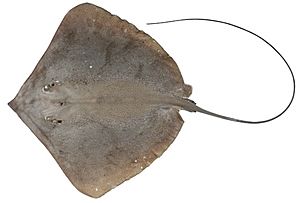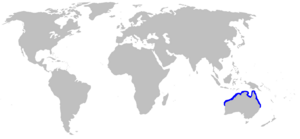Brown whipray facts for kids
Quick facts for kids Brown whipray |
|
|---|---|
 |
|
| Conservation status | |
| Scientific classification | |
| Genus: |
Maculabatis
|
| Species: |
toshi
|
 |
|
| Range of the brown whipray | |
| Synonyms | |
|
|
The brown whipray (Maculabatis toshi) is a type of stingray. It belongs to the family Dasyatidae. You can often find it in muddy areas along the northern coast of Australia. This ray has a unique diamond-shaped body and a very long, thin tail.
It is usually plain brown on top and white underneath. Sometimes, it has small white dots near the edge of its body. The tail is dark, with dark and light bands near the end. The largest brown whipray ever recorded was about 74 cm (29 in) wide.
Brown whiprays eat crustaceans and small bony fishes. Female rays give birth to 1 or 2 young at a time. They feed their babies with a special "uterine milk" inside their bodies. The International Union for Conservation of Nature (IUCN) says the brown whipray is of "Least Concern". This means it is not currently in danger of disappearing. This is because most of them live in Australian waters. Here, special devices on fishing boats help protect them. However, more are caught in the Arafura Sea for food, skin, and cartilage.
Contents
About the Brown Whipray
How it Got its Name
The first brown whipray was found in 1903. It was a male ray about 31 cm (12 in) wide. It was collected from the estuary of the Clarence River in New South Wales. An Australian scientist named David George Stead first thought it was a different type of stingray.
Later, in 1939, another scientist named Gilbert Percy Whitley realized it was a new species. He described it in a science magazine called Australian Zoologist. He named it after James Tosh, a marine biologist from Queensland. Even after this, many people still confused the brown whipray with other types of stingrays.
Family Tree of the Ray
In 2004, a scientist named Mabel Manjaji grouped the brown whipray with several other similar species. These rays are all part of what is called the 'uarnak' species complex. The black-spotted whipray (M. astra) is a very close relative. People once thought it was the same species as the brown whipray. Other common names for this ray include coachwhip ray and Tosh's whipray.
What Does it Look Like?
The brown whipray can grow up to 74 cm (29 in) wide and 1.7 m (5.6 ft) long. Its body, called a disc, is shaped like a diamond. It is also quite thin. The front edges of the disc are almost straight. They meet at a wide angle at the ray's snout. The snout itself is pointed and sticks out a little.
Its eyes are a good size. Right behind the eyes are the spiracles. These are like breathing holes. The nostrils are long and thin. Between them is a short, wide flap of skin. The mouth is small and shaped like a bow. It has four small bumps on its floor.
The pelvic fins are small and narrow. The tail is very thin and looks like a whip. It does not have any fin folds. Usually, there is one stinging spine on the top of the tail. When the tail is complete, it can be 2.5 to 3 times longer than the disc is wide.
The ray's skin has small, heart-shaped bumps called dermal denticles. These bumps run from between its eyes all the way to its tail. In the center of the disc, there are 3 to 4 larger, spear-like thorns. There are also smaller thorns in rows in front of these.
The brown whipray is a dark olive-brown color on top. It gets lighter towards the edges of its body. Its underside is plain white. Sometimes, older rays have small pale spots near the edge of their disc. The tail is dark both above and below. It has alternating black and gray bands near its tip.
Where Does it Live?
The brown whipray lives off the coast of northern Australia. You can find it from Shark Bay all the way to the Clarence River. However, it has not been seen in the southeastern part of its range for some time.
This ray lives on the bottom of the ocean. It prefers shallow, muddy places like mangrove flats. It seems to like living closer to the shore than the black-spotted whipray. In Shark Bay, more brown whiprays are found during the warmer months than in the colder ones.
Life and Habits
What it Eats
The brown whipray is a predator. It hunts and eats crustaceans, like crabs and shrimp. It also eats small fishes. Young brown whiprays have been seen moving with the tide to find food.
Its Babies
Like other stingrays, the brown whipray gives birth to live young. The developing embryos grow inside the mother. They are fed by a special "uterine milk" that the mother produces. Female brown whiprays usually have 1 or 2 babies at a time. Each baby ray is about 20–22 cm (7.9–8.7 in) wide when born. Male rays are ready to mate when they are about 40 cm (16 in) wide. Females are ready when they are about 66 cm (26 in) wide.
Who Hunts It?
Some small creatures are parasites of the brown whipray. These include certain types of tapeworms.
Brown Whiprays and People
The brown whipray is quite common in the areas where it lives. It is often caught by fishing boats that use large nets, called bottom trawls and beach seines. These fisheries operate in the Arafura Sea. The skin of the brown whipray is very valuable. Its meat and cartilage are also used.
In the past, this species was one of the most common elasmobranchs (sharks and rays) caught by accident. This happened in the Northern Prawn Fishery (NPF) of northern Australia. However, many of the rays caught this way seemed to survive.
The number of rays caught by accident has dropped a lot. This is because Australian fishing boats now have special devices. These are called Turtle Exclusion Devices (TEDs) and other bycatch reduction devices. These devices help prevent unwanted animals from being caught in the nets.
Most brown whiprays live in Australian waters. Here, they are not greatly threatened by human activities. Because of this, the International Union for Conservation of Nature (IUCN) has listed the brown whipray as "Least Concern". This means it is not considered to be in danger of extinction.
|


